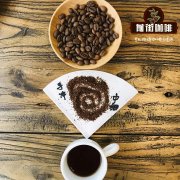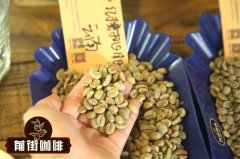Where does Kona Coffee come from Hawaii? what are the best estates that produce Hawaiian Kona Coffee?

Professional coffee knowledge exchange more coffee bean information please follow the coffee workshop (Wechat official account cafe_style)
According to a newly released selection by USA Today, the famous Hawaiian Kona Coffee Farm on the Big Island of Hawaii-Greenwell Kona Coffee Farms beat the food factory trip of many international well-known food brands and was selected as one of the "Ten Best Food Factory Tour in the United States". This honor once again puts Kona Coffee Coffee on the dazzling stage, letting more coffee lovers know and know Kona Coffee from the Big Island of Hawaii. Every November, a grand Kona Coffee Festival is held on the Big Island of Hawaii to celebrate the harvest of coffee and to promote Kona coffee culture to tourists from all over the world. Today, we will join Greenwell Kona Coffee Farms Coffee Farm to learn about the whole process of sowing, growing, harvesting and making coffee beans in Kona Coffee, and experience the wonderful journey of "farm to coffee cup" (From Farm to Cup).
Greenwell Kona Coffee Farms Kona Coffee Farm, located on the Big Island of Hawaii, was founded in 1850. The founder Greenwell family emigrated from Britain to Kona, Hawaii, where they engaged in coffee and animal husbandry. It was also one of the first Kona coffee farms in the world to export Kona coffee to the United States and even Europe. Today, Tom Greenwell continues to run the family Kona coffee business, and the farm has grown into one of the few large Kona coffee origins.
The climate in the Kona region of the Big Island of Hawaii is perfect for protecting the growth of young coffee trees, and small coffee seedlings grow slowly in Greenwell's elaborate greenhouse. Although the core of the Greenwell Kona Coffee Farms farm is Hawaiian Kona coffee, the farm often tries to grow other crops, such as green peppers, cocoa beans and taro. Small Kona coffee saplings usually take several years to grow into coffee trees and bear coffee fruit.
Even coffee lovers, many people may not know that the aroma of coffee flowers is also very charming, even a short bloom will emit a unique aroma. If you are lucky, you can also see the white coffee flowers on the Greenwell Kona Coffee Farms farm. Every coffee tree on the farm has been carefully built and cultivated, each coffee flower will bear a coffee fruit, this small coffee fruit will produce two coffee beans, isn't it amazing!
January, February and March are the rainy season in Hawaii. Rows of coffee trees are instantly covered with white coffee flowers. From afar, it looks as if the trees are covered with white snowflakes, also known locally as "Kona Snow". Although different coffee trees bloom at different times, many studies on coffee cultivation in recent years have helped local farms try to make all coffee trees bloom at the same time. This advantage is: to facilitate the later more efficient large-scale picking of coffee fruit, but also to ensure the best quality coffee beans.
Experienced coffee pickers will pick and screen a single coffee fruit themselves, and many of the pickers at Greenwell Kona Coffee Farms Farm are employees with more than 25 years of experience. Picking by hand is still an ancient method, but it is also one of the guarantees of high-quality Kona coffee. In addition, the ripening state of each coffee fruit is different, which makes it difficult for the farm to use machines to pick coffee fruits in bulk. Interestingly, farms have also found that experienced female pickers tend to be the best pickers. As for the short stories of picking coffee beans during the harvest season, you might as well go to the farm to learn about them.
The picked coffee fruit needs to be treated. At present, the two main methods are sun-drying and water-wet method. In the sun-drying method, the coffee fruit is directly exposed to the sun to dry, and finally the moisture content is reduced to 11%. The water-wet method uses a pulp washer to wash off the peel and pulp of the coffee fruit and then dry it or dry it directly in the sun. Coffee beans have gone through many manual procedures at this stage, and the strict quality control of each step is also a necessary guarantee for top coffee beans.
The roasting technology of coffee is also an art in itself, and the roaster determines whether the coffee beans are roasted properly by sound, color and taste. Timing is the key. Baking time affects the color and taste of the final product, so the baking time depends on what kind of coffee you want.
Finally, after vacuum packaging, to maximize the freshness of coffee beans, a packet of high-quality 100% Kona coffee beans will be produced! Greenwell Kona Coffee Farms Farm offers free farm tours to all customers who come to the farm, watching the coffee production process and tasting all kinds of Kona coffee for free. Whether you like coffee or not, the whole process of this small coffee bean from cultivation and sprouting to roasting into a fine coffee bean is a farm trip that can't be missed!
After a visit to the free Kona Coffee Farm in Hawaii, visitors can enjoy Kona coffee for free and buy some as travel souvenirs at the gift shop if they like.
Important Notice :
前街咖啡 FrontStreet Coffee has moved to new addredd:
FrontStreet Coffee Address: 315,Donghua East Road,GuangZhou
Tel:020 38364473
- Prev

Which is the best Hawaiian local coffee? why is Hawaiian Kona coffee famous in the world?
Professional coffee knowledge exchange more coffee bean information please follow the coffee workshop (Wechat official account cafe_style) excellent! The volcano on the Hawaiian Kona Coffee Island nurtured by tears, the Hawaiian volcano goddess, is a goddess of fear and love among local residents. She is afraid of the goddess's anger, and her home is torched instantly, but she also loves the tears left by the goddess after her anger, high temperature and thick magma, cold.
- Next

Is Sakui coffee from Sidamo? what are the characteristics of Sidamo coffee?
Professional coffee knowledge exchange more coffee bean information please follow Coffee Workshop (Wechat official account cafe_style) GUJI is the largest coffee producing area in Ethiopia. Sakuran is from Hambella, one of the sub-regions of Guji. At present, there are about 20 processing plants of various sizes in Hambella producing areas. Hongshun as a "rooted" Ethiopian coffee production
Related
- Does Rose Summer choose Blue, Green or Red? Detailed explanation of Rose Summer Coffee plots and Classification in Panamanian Jade Manor
- What is the difference between the origin, producing area, processing plant, cooperative and manor of coffee beans?
- How fine does the espresso powder fit? how to grind the espresso?
- Sca coffee roasting degree color card coffee roasting degree 8 roasting color values what do you mean?
- The practice of lattes: how to make lattes at home
- Introduction to Indonesian Fine Coffee beans-- Java Coffee producing area of Indonesian Arabica Coffee
- How much will the flavor of light and medium roasted rose summer be expressed? What baking level is rose summer suitable for?
- Introduction to the characteristics of washing, sun-drying or wet-planing coffee commonly used in Mantenin, Indonesia
- Price characteristics of Arabica Coffee Bean Starbucks introduction to Manning Coffee Bean Taste producing area Variety Manor
- What is the authentic Yega flavor? What are the flavor characteristics of the really excellent Yejasuffi coffee beans?

